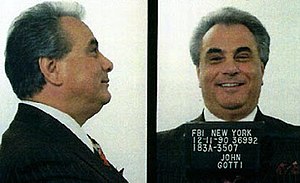Structure Keeps Mafia Atop Crime Heap
Over the past three decades, Russian mobsters, Chinese gangsters, Mexican cartels and a host of other groups have all grabbed slices of the criminal activity traditionally dominated by the mafia.
But none have come close to exerting the kind of wide-ranging influence still enjoyed by La Cosa Nostra, as the Italian-American mob is known.
That is partly because of how the different gangs have organized themselves. The mafia has a strict hierarchical structure, law-enforcement officials said, and it has proven capable of finding new soldiers. Even after imprisonment of senior leadership, it survives, and in some places thrives, though most experts agree that its operations are now largely confined to its traditional bases in the Northeast and Chicago.
This week's round-up of more than 100 suspected mob members and associates is unlikely to stop the mafia's core businesses: extortion, loan-sharking, fraud and theft. Yet the arrests also indicate how difficult it is these days to be a mafia leader—paranoid about informants, afraid of telephones and dreading the early-morning knock on the door.
"We aggressively attack them…and the sentences are very large, but they continue to roll the dice," said David Shafer, who heads the Organized Crime Branch in the Federal Bureau of Investigation's New York Office, which also has squads dedicated to Russian and Asian gangs.
The mob has evolved in part by outsourcing, contracting out some of its criminal work to motorcycle gangs, according to Howard Abadinsky, a professor at St. John's University who writes about organized crime. The so-called Outlaws gang has done a lot work in recent years with the Chicago mob, while the He
 Deceased Gambino Boss John Gottill's Angels are used by New York City's mafia families. Philadelphia mobsters use a gang called the Pagans.
Deceased Gambino Boss John Gottill's Angels are used by New York City's mafia families. Philadelphia mobsters use a gang called the Pagans.Russian gangsters were once feared as the next criminal superpower. But their looser structure, which helps them avoid detection by law enforcement, has also kept them from growing into an organization able to recruit the number of members needed to challenge the mafia.
The Russian networks tend to come together briefly for particular criminal plots and then disband, according to Michael Vecchione, who heads the rackets division at the Brooklyn district attorney's office.
Mr. Shafer, the FBI official, said some Russian crooks also realized there were great profits to be made in white-collar crime, such as scams involving insurance or medical fraud, "so why do the extortion or gambling?"
Most Asian gangs, meanwhile, tend to victimize only members of their own immigrant group and therefore remain small compared with much larger mafia families, experts who study the groups said.
In the late 1980s, Chinese and Vietnamese gangs such as the Ghost Shadows, Born to Kill and Flying Dragons were operating in New York City's Chinatown, engaging in gambling, drug-trafficking, prostitution, robbery, extortion and other crimes, including murder.
A series of racketeering prosecutions effectively dismantled the most dangerous of those groups, according to Mr. Shafer, reducing them to smaller, less ambitious groups that he said were more akin to "roaming wolf packs" than true street gangs.
But the true breadth and penetration of some ethnic gangs isn't entirely clear. For instance, Russian criminal networks are particularly difficult to crack because of the foreign-language expertise required, experts said.
One area dominated by the newer gangs is the U.S. drug trade, where Mexican cartels are now challenging the Colombians for supremacy, said John Gilbride, special agent in charge of the U.S. Drug Enforcement Administration's New York Office.
The shift in power began in the mid-1990s when the Colombian drug lords started paying the Mexican cartels—whose members transported the cocaine and heroin into the U.S. in tractor trailers and vehicles with hidden traps—with drugs instead of money.
But Mr. Abadinsky said the big drug cartels were "one-trick ponies" and didn't participate in non-drug-related crime since nothing else was as profitable.
So while the days of John Gotti—the "Dapper Don" whose swagger and scheming made him the most wanted mobster of his time—are long gone, the Italian-American mob remains the most powerful criminal enterprise in the U.S., mafia observers say.
A former mobster, who first joined a New York crime family 25 years ago, said: "The mob is still around but the education to it ain't there."
But he said the mob always had a comeback. "It will regroup. Everybody will lay low and see what happens. Then all of a sudden, little by little, they'll come out and they'll start regrouping. They gotta. There's too much money, and you gotta remember their egos won't let them walk away."
http://online.wsj.com/article/SB10001424052748704115404576096392318489246.html








0 comments:
Post a Comment